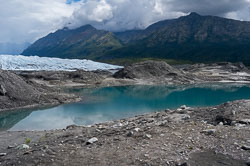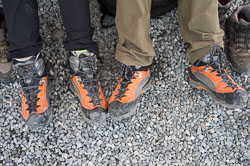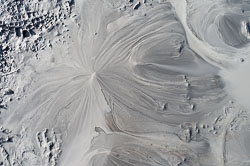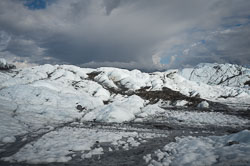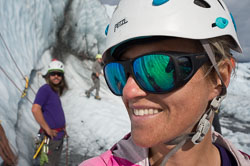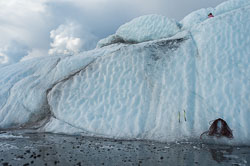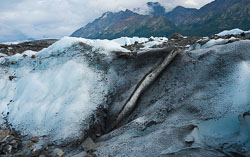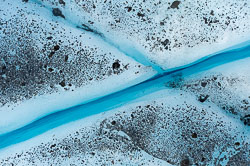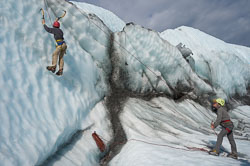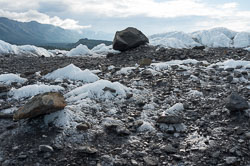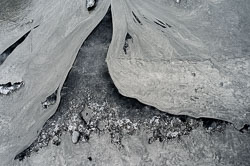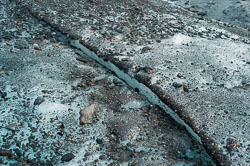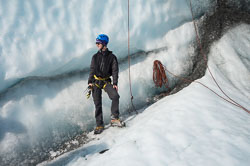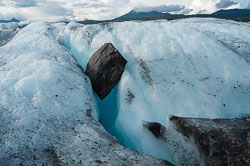The Matanuska Glacier
with the Leica X-U By David Knoble on December 24, 2017

This article was first published in Viewfinder, Volume 50, No 4 of the International Leica Society, LHSA
The Leica X-U is a unique camera in the Leica lineup. The APS-C sized CMOS sensor, 23mm Summilux f/1.7 lens and battery are the same used in the Leica X. However, the similarities stop there. The X-U is water and dust sealed. Not just 'resistant' but sealed. The X-U can be used in shallow depths up to 15m under water for 60 minutes at a time. There is even a special under water filter that corrects the color cast so images taken under water have a natural color. Just as interesting, the X-U can also be covered in mud or sand and just rinsed off lightly to clean it up. Add the bright orange Leica X-U camera strap, which floats if the camera is dropped in the water, and the Leica X-U is the perfect camera to take ice climbing on the Matanuska Glacier in Alaska. I spent the last day of a two-week adventure with the Boy Scouts of America in and around this glacier. Some of the best images I took from the entire excursion are from this day on the glacier.
The largest glacier accessible by car in the United States is the Matanuska Glacier. Boasting 43 km (23 miles) long and 6.4 km (4 miles) wide at the terminus (the end), this valley glacier is about 160 km (100 miles) from Anchorage, Alaska . The glacier melts during the warmer weather, feeding the Matanuska River.
A valley glacier is a body of solid ice that moves down an existing valley, much like a river, due to its own weight. During the process, they carve a valley. Because of the large amount of ice, the air directly above it is much colder than the surrounding air, causing the warm air to be pushed up to the tops of the surrounding mountains. The result is sunny skies over the glacier, even when there are thunderstorms surrounding it .
Glaciers are incredibly interesting because some attributes make them appear alive. Glaciers move, grow and decay, each year. The Matanuska Glacier moves about 1 foot per year. However, through the process of melting in the warmer weather, called ablation, the end of the Matanuska Glacier, or terminus, has not moved any appreciable amount since 2007 . At some point, if the melting accelerates, then the glacier will actually begin to recede from its current location.
Matanuska is derived from a Russian term spelled in several different ways, including "Matanooski" and "Mednoviska." The term is translated as "copper river people" and is speculated as a reference to an old route from Cook Inlet to the Copper River. The Matanuska-Susitna Valley is referred to by locals as the "Mat-Su" or simply, "The Valley." Glaciers carved this 56 km (35 mile) area, which has resulted in thousands of lakes today.
We begin our adventure with the Nova Alaska guides. Our three guides have varying experience and are from widely different places. One guide lives in Alaska, one in the Midwestern United States and one comes from Czechoslovakia. A short ride through the privately owned land housing the only way to the terminus of the Matanuska glacier and we arrive.
The sun is bright as we park the cars, but the mountain ranges on each side of the glacier hold back dark, ominous rain clouds. The glacier stands before us, below the parking plateau, with what looks like a combination of dirt, large puddles and mud between us and the ice.
Descending from the parking lot, we see the dry dirt quickly turn to muck. We traverse the open swamp on metal walking boards just wider than a two foot stance. The crisscrossing of walk ways cover the glossy mud. We learn the glacier is below us, even though we see what looks like dirt and mud. Tens of feet below is the hard glacial ice. On top is a plasti-layer. We carefully step off the platforms and our weight causes water to push up through the plastic mud-like layer around our shoes. Too much weight and the layer could break causing us to be stuck in something resembling quick sand.
We continue towards an area covered in black gravel we find is glacial ice at the surface, covered in stone that has been ground and pushed up from the bottom of the glacier. The movement of the heavy ice grinds the stone and pushes it up. Here we adorn the crampons and begin to walk, our feet sticking in the ice like flies on flypaper. Newfound freedom on what instantly transitioned from mud to slick, white, ice.
As we walk and learn more about the glaciers, I set the Leica X-U to automatic exposure on the lowest ISO. I use an EV compensation of +2/3 stop and let the rubber lens cap dangle from the string attaching it to the body. I know the cover over the lens will protect it. Since the X-U only has the LCD on the back with no electronic or optical finder, I find myself holding it out so I can frame an image and making sure the autofocus spot is on the subject. This is a different stance for someone so used to rangefinders. Using various f/stops ranging from 2.0 to 8.0, I click away with no shortage of awe inspiring subject matter.
We continue walking and I keep thinking the scenery could not improve. The temperature is chilly, but not too cold. The blue in the ice from the light shining through mixes with the black pepper flakes of dirt and rubble. Everything has crisp detail and varying tones from dark to light - nothing like I expected a large block of ice to show. The X-U captured the detail in the highlights and the shadows. Even with the APC sized sensor, the images looked crisp on the LCD. The 23mm lens, equivalent to 35mm in full frame, allowed both close-up shots and sweeping wide angles. I feel like a 10 year old in a candy store.
We spend a short time learning ice climbing with the crampons and ice tools (ice axes are not the same as ice tools we learn) and begin to climb an ice bank. I can attest that trusting spikes on shoes to hold you up while hammering a tool into the ice for the next step is harder than one might think. We climb a variety of ice walls, some tipping back towards us causing gravity to work against us; and some with vertical ridges making use of the crampons more challenging. The guides are patient teachers and work well with everyone.
Moving on, we hike in an around the ice mountains. Deep crevasses border one side with hues of blue going down below. Some of the ice glistens in the sunshine melting into channels of water that are either inches deep or a hundred feet deep. The ice and debris make it impossible to tell. The X-U captures it all with precision and little effort. Simply a shutter speed or f/stop change and more images feed to the SD card.
Glacier ice is very different from other ice. Yes, ice is frozen water, period. But the natural process of adding ice to a glacier is complex. Snow has to create a layer on top of the glacier during winter. Then, with the warmer summer weather, the snow will melt and begin to compact. However, the snow cannot completely melt or no new ice will form. This process continues with new snow adding weight and insulation for a period ranging from 6 to 8 years, although some can take 100 years to properly form . One Nova guide explains to me that between 10 to 12 inches of snow is needed to form 1 inch of glacial ice. The first year is so crucial because the snow is fully exposed on top.
Now imagine the process. If a glacier receives ten feet of snow one winter and all the snow survives the warm weather, the glacier may grow ten inches in 6 to 8 years. However, the warm weather also melts glacial ice around the edges. Scientists measure the life expectancy of a glacier based on the net new growth less the melting outside of winter. Some glaciers that have been in equilibrium are beginning to recede. This tells scientists that the glacial ice is melting faster than new ice can grow. Warmer weather can accelerate the process not only by melting more ice, but also by producing more snow.
We continue hiking and move around the south side coming back through an area littered with rocks. One rock the size of small house is lodged in a giant crevasse. On the other side the rocks are smaller but littered all around, covering the white ice and complementing the backdrop of the mountain ranges that contain the glacier. My stereotype of blinding white glaciers is forever changed. The natural scenery is filled with interesting colors and dark tones. The melting ice produces sculptures that live just long enough. Change is inevitable and constant. At one point, we witness a several ton block of ice fall and hear the ensuing crash that reminds me of a canon blast echoing in the mountains.
The Mat-Su exceeded my expectations and the Leica X-U matched my experience recording the incredible images I had the privilege of seeing. The X-U is a weather and dirt resistant camera that I had no trouble setting down in the ice, mud or dirt. It just worked. I also felt different coming home. This experience caused me to be so much more aware of the impact daily pollution has on our environment and the need for us all to change. We need to spend more efforts recycling, reusing and reducing our carbon footprint to protect the earth that remains our home.

